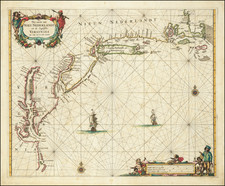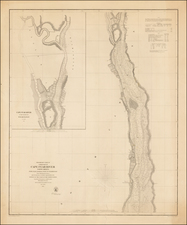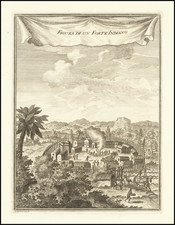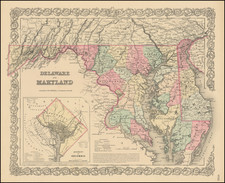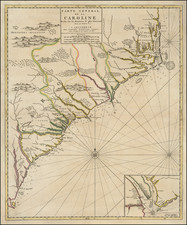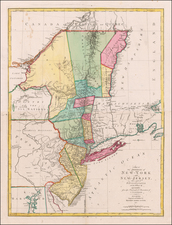Very rare - the earliest issue from John Bachmann's celebrated series of bird-eye views of the U.S. Civil War, depicting the Virginia-Maryland theatre on the eve of conflict.
This magnificent bird's eye view captures the Virginia-Maryland theater of the United States Civil War (1861-1865) from a panoptic perspective, taken shortly before the actual hostilities had commenced. The artist, John Bachmann, Sr., employed great imagination and skill to capture the geography almost as if it was shot from a low orbit satellite.
The view embraces most of Chesapeake Bay, Central Maryland, Eastern Virginia and the District of Columbia and looks dead southward from a stratospheric vantage point just to the south of the Mason-Dixon Line. The means by which the Chesapeake and its tributaries, the James, York, Rappahannock and Potomac rivers are conveyed, creates the visual effect of drawing the viewer into the scene. Washington, D.C. is located almost at the center, while further south is the Confederate capital of Richmond, the key city of Petersburg and near the mouth of the Chesapeake, the great naval ports of Newport and Portsmouth. In the lower left corner is the major commercial port of Baltimore, with Fort McHenry (where the 'Star-Spangled Banner' was composed in 1814) and in the lower right corner is the town of Harper's Ferry, Virginia.
This magnificent view was likely made in the late spring of 1861, after the Civil War had commenced but before the conflict had entered the Virginia-Maryland theater in earnest. The Confederate States of America were officially constituted on February 4, 1861. From that point onwards, war had been universally anticipated, although nobody was sure where the first shots would be fired.
The suspense was lifted upon the Battle of Fort Sumter in Charleston Harbor, South Carolina, on April 12-14, 1861. Following that event, an uneasy situation developed. The Confederates prepared for a defensive conflict, while the Union Army, with its vast numerical and technological superiority vacillated and it was many weeks before major battle were joined. Indeed, many on the Northern side were initially complacent, assuming that the Union would effortlessly crush the rebels whenever the occasion arose.
It was during this tense and frankly odd time, that Bachmann made the present view, the earliest of his celebrated Civil War series. As it was widely viewed that major battles would be joined somewhere in between the Union and Confederate capitals, Bachmann sought to anticipate events. In fact, the region had already seen some conflict related to the war. On October 16, 1859, in Harper's Ferry, In Virginia (which would become a part of West Virginia in 1863), the radical abolitionist John Brown seized the United States Army arsenal in an effort to acquire arms to support a hoped-for slave rebellion against the South. Brown's efforts were quickly brought down, however, the raid on Harper's Ferry presaged the bloodshed that was to come.
While Bachmann's view shows the roads, railways and valleys that would soon facilitate military movement, it features no battle information. The war in the region began in earnest later on, with the First Battle of Bull Run (or the First Battle of Manassas) on July 21, 1861. Shortly before the opposing armies met in Prince William County, Virginia, just outside of Washington, Union dignitaries prepared picnics on an overlooking ridge, where they eagerly expected to watch the Union Army decimate the Confederate forces. However, events did not transpire as planned, as the Southerners quickly broke the Union lines, sending the Northern army (and the spectators) in a headlong retreat!
While the Union eventually seized the areas of northernmost Virginia near the Potomac, the Confederates also won the Second Battle of Bull Run, fought on August 28-30, 1862. The conflict then proceeded to Sharpsville, Maryland, located just off of the view, where the Battle of Antietam was fought on September 17, 1862. This epic altercation, which involved 113,000 troops, resulted in a technical draw but a strategic Union victory, as the Southerners were prevented from continuing their planned invasion of the North.
The theater depicted on the view also featured the final showdown of the war, the Richmond-Petersburg Campaign, by which after a long siege lasting from June 1864 to March 1865, the Union seized the Confederate capital of Richmond. The war was ended soon thereafter with the Confederacy's complete surrender on April 9, 1865, at Appomattox Court House, Virginia.
It would appear that Bachmann's publisher, A. Rumpf, issued relatively few copies of the present view, as later that year Bachmann elected to shift to the publication of an entirely new view of the same Virginia-Maryland theater, Panorama of the Seat of War. Birds eye view of Virginia, Maryland, Delaware, and the District of Columbia (issued from 1861 to 1864). /gallery/detail/23656 . This view captured the region from an easterly perspective and ran into four states, being updated with the locations of battles (marked by crossed-swords). The various states of this view were each printed in far greater numbers than Bachmann's present earlier view.
John Bachmann, Sr. (1814-1896) was one of the most successful and talented artists of American bird's-eye views. Born in Switzerland, he worked in his native country and in Paris, before immigrating to America in 1847. His first known lithograph published in America was a bird's-eye view of Lower Manhattan taken from Union Square (1848). In the next couple of years, Bachmann became highly prolific, publishing a series of city views that included Boston, New York, Philadelphia, New Orleans and Havana. He pioneered a technique of creating views from imaginary stratospheric perspectives, amazing accomplishments that required unusual technical élan and creativity. His work dazzled the public and was widely imitated by publishers (usually with much less skill) across both America and Europe.
During the U.S. Civil War, Bachmann published a series of bird's-eye views of different theatres of the conflict, which many consider to be his most important works. Some of his views, when considered together, covered the entire region of the war, from Coastal Texas in the South up to Pennsylvania in the North. The panoptic perspective offered by his views made the geography and the suddenly famous locations of events come alive to a highly curious general public who, in many cases, never visited any part of the war theatre.
Following the war, Bachmann continued to produce fine city views from his studio in Jersey City, New Jersey. His son, John Bachmann, Jr., followed his father into the art lithography profession. Bachmann's work is today widely admired by both historians and connoisseurs of 19th Century American art and his work figured prominently at an exhibition at the Metropolitan Museum of Art in 2000, Art and the Empire City: New York, 1825-1861.
While Bachmann's other views of Civil War theatres appear from time to time, this particular view seems to be by far the rarest of the series. Few copies were originally issued before the run was discontinued by the publisher and many of the examples that were produced had a short life span, as they were often tacked and mounted to walls and exposed to wear and tear. The present example is a very rare survivor, as we can locate only 5 institutional examples (but no example in the collections of the Library of Congress) and no auction or dealer catalog records in Americana Exchange or AMPR from the last 30 years.









